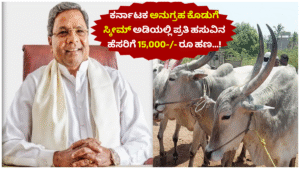1. Introduction
The Anugraha Koduge Scheme (“Grace Gift”) is a livestock welfare initiative by the Karnataka government. It provides financial assistance to livestock owners, particularly shepherds and small dairy farmers, when their animals die due to natural causes, disease, or accidents. This aims to cushion rural households from economic shocks and promote sustainable animal husbandry.

2. Historical Background
- 2013 Launch: Introduced under CM Siddaramaiah’s government to compensate livestock losses:
- ₹2,500–₹5,000 for goats/sheep
- ₹10,000 for cattle.
- 2020 Suspension: Paused under the BJP government due to budget constraints and COVID-19 disruptions. Protests followed as many shepherds suffered economic hardship.
- 2023 Revival: Reinstated in September 2023 with the same compensation structure.
- 2025 Upgrades: In the 2025–26 budget, compensation rates were increased and funds allocated for additional veterinary clinics and infrastructure.
3. Benefits & Structure
Compensation Rates (2025):
| Animal Type | Compensation (₹) |
|---|---|
| Sheep/Goat (3–6 months) | ₹3,500 |
| Adult Sheep/Goat (>6 mo) | ₹6,000 |
| Cattle (cow/buffalo) | ₹12,000 |
| Shepherd Accidental Death | ₹5 lakh (insurance) |
| Housing Aid | ₹5 lakh for house+shed |
(Source: Karnataka Sheep & Wool Development Corporation)
Other Provisions:
- ₹5 lakh life insurance for migratory herders.
- Subsidies for constructing homes with animal sheds for backward-class shepherds.
4. Eligibility & Application
Who Can Apply?
- All livestock owners in Karnataka.
- Focus on SC/ST and economically weaker sections.
Documents Required:
- Pre- and post-death photographs of animals.
- Veterinary post-mortem certificate.
- Aadhaar-linked bank account details.
- FIR in case of accidental death.
Application Process:
- Report the death to the local veterinary officer within 24 hours.
- Submit required documents at the Taluka Animal Husbandry Office.
- Verification by veterinary committee.
- Compensation disbursed via Direct Benefit Transfer (DBT).
5. Implementation & Impact
- Pending Compensation (2024): ₹65 crore pending for ~1.3 lakh livestock deaths (source: The Times of India).
- Reinstatement Effect (2023): Within 2 months, ~4,000 families received ~₹3 crore.
- Veterinary Upgrades: 50 new clinics sanctioned in 2025 budget; focus on rural veterinary outreach.
Field Insights:
“It took 2 years for my compensation to arrive for 10 dead sheep. The process is tedious.” – Farmer, Haveri (The Hans India).
6. Challenges
- Delays in Disbursement: Farmers report 6–12 month waits due to budget release bottlenecks.
- Documentation Barriers: FIRs and photo evidence are difficult to obtain in remote areas.
- Inadequate Compensation: Market price for adult goats (
₹20,000–₹25,000) far exceeds the current payout (₹6,000). - Vet Infrastructure Gaps: Shortage of vets in rural Karnataka hampers timely verification.
7. Comparison with Other States
| State | Compensation for Goats | Cattle |
|---|---|---|
| Karnataka | ₹6,000 | ₹12,000 |
| Telangana | ₹15,000 | ₹20,000 |
| Maharashtra | ₹2,000–₹4,000 | ₹6,000–₹8,000 |
Karnataka offers higher payouts than Maharashtra but lags behind Telangana.
8. Future Outlook
- Proposed Reforms:
- Scale payouts to match market prices.
- Simplify applications with mobile apps for remote farmers.
- Quarterly budget allocation to avoid delays.
- Awareness campaigns in Kannada to improve participation.
- Third-party audits for transparency.
- 2025–26 Budget Priorities:
- ₹100 crore earmarked for animal welfare.
- Veterinary infrastructure expansion to address service gaps.
9. Key Takeaways
| 🔑 Aspect | 💡 Current Status & Suggestions |
|---|---|
| Compensation Rates | Increased but still below market values. |
| Vet Infrastructure | Needs further expansion for rural access. |
| Application Process | Simplification required (mobile app recommended). |
| Fund Disbursement | Quarterly release to reduce bottleneck |










